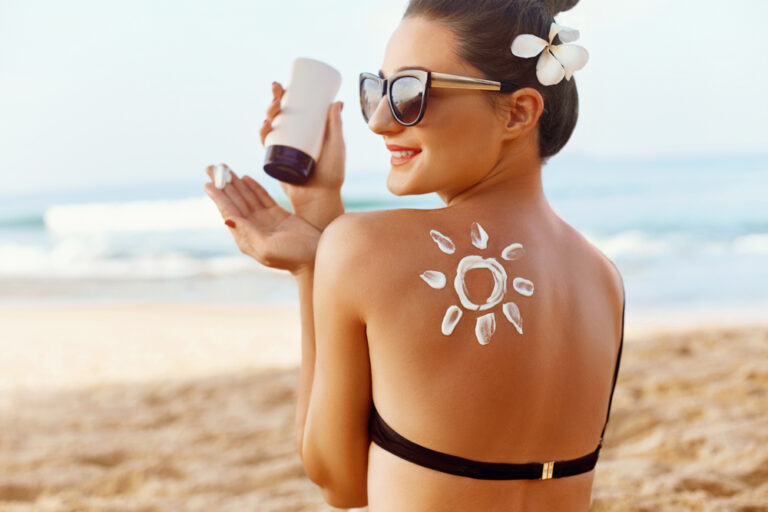GOOD HOUSEKEEPING
Sunburns are like hangovers — the best thing is not to get one in the first place. “Especially if you have fair skin, it’s easy to think, I get little burns all the time; I know how to deal with it,” says Crystal Aguh, M.D., an assistant professor of dermatology at Johns Hopkins School of Medicine. But each burn you get ups your risk of skin cancer. Enjoy the outdoors without catching too many rays using these proven strategies.
USE SUNSCREEN (EVEN IF YOU HAVE DARK SKIN). A dark complexion offers some natural protection, but “no matter what your skin tone, it’s not enough to ward off the damage that can lead to cancer,” says Melanie Palm, M.D., director of Art of Skin MD in San Diego and an assistant clinical professor of dermatology at the University of California, San Diego. Not to mention the aging effect of UV rays: “The breakdown of collagen, blood vessel damage, age spots, uneven pigmentation — it’s all related to sun exposure,” she says.
DON’T SKIMP ON SPF ON CLOUDY DAYS. UV rays can penetrate clouds, and some overcast conditions can even enhance sun exposure. Scientists think that’s because certain types of clouds can reflect and scatter the sun’s rays, increasing the amount of radiation that makes it to Earth’s surface. Lotion up!
FIND THE RIGHT FORMULA. Sunscreen comes in two basic types: physical and chemical. Physical sunscreen, also known as sunblock, bounces UV rays off the surface of skin, while chemical sunscreen helps absorb them. If you have darker skin, you may prefer the chemical kind, since physical blocks tend to be white, pasty and hard to rub in. People with acne may also prefer a less goopy chemical sunscreen. Physical blocks can be less irritating, so they’re a better choice for those with allergies or sensitive skin. Not sure which is which? If the label lists only zinc oxide or titanium dioxide, it’s a physical sunscreen.
BUY BROAD-SPECTRUM. The FDA requires that sunscreens dubbed “broad-spectrum” be proven to shield against both UVA and UVB rays, the two major types. “UVA rays contribute more to aging damage, while UVB ones cause burns,” says Dr. Aguh. “Both increase your cancer risk.”
SQUEEZE OUT A SHOT GLASS’S WORTH. “You probably need to put on twice as much as you think,” says Dr. Palm. A full-body application requires about an ounce, or a shot glass full. “For a beach day when you need to reapply every couple of hours, a four-ounce bottle of sunscreen should only last a day,” she says. Apply a thick coating: “If you use SPF 30 but apply only half of what you should, you’re getting roughly the equivalent of an SPF 15,” Dr. Palm adds.
TRY A SPRAY TO PROTECT YOUR SCALP. When it comes to the rest of your body, “spray sunscreens are generally not nearly as protective as creams,” says Amy Kassouf, M.D., a dermatologist at the Cleveland Clinic. But it’s smart to spritz any exposed area of your scalp with an invisible spray. Be sure to use a generous amount and rub it in.
PUT THE OLD “BASE TAN” MYTH TO REST. Hear this: “There is no such thing as a safe tan,” says Dr. Aguh. “Number one, any browning of the skin — even if you don’t burn — is a sign of sun damage. Two, a tan doesn’t afford you much protection. It’s the equivalent of an SPF of 3 or 4, and that’s not going to cut it.”
EAT TO BEAT MELANOMA. A diet full of colorful antioxidant-rich foods may reduce your skin cancer risk. One study found that a Mediterranean diet that included tea, fish and lots of produce was associated with decreased risk. And there’s good news for caffeine addicts: Other research found that drinking lots of caffeinated coffee (at least four cups a day) was associated with a significantly reduced risk of malignant melanoma.
CHECK THE EXPIRATION DATE. “Sunscreens are meant to last up to three years, but high temperatures can cause them to degrade faster,” says Dr. Aguh. The upshot: Don’t keep using last summer’s bottle.

